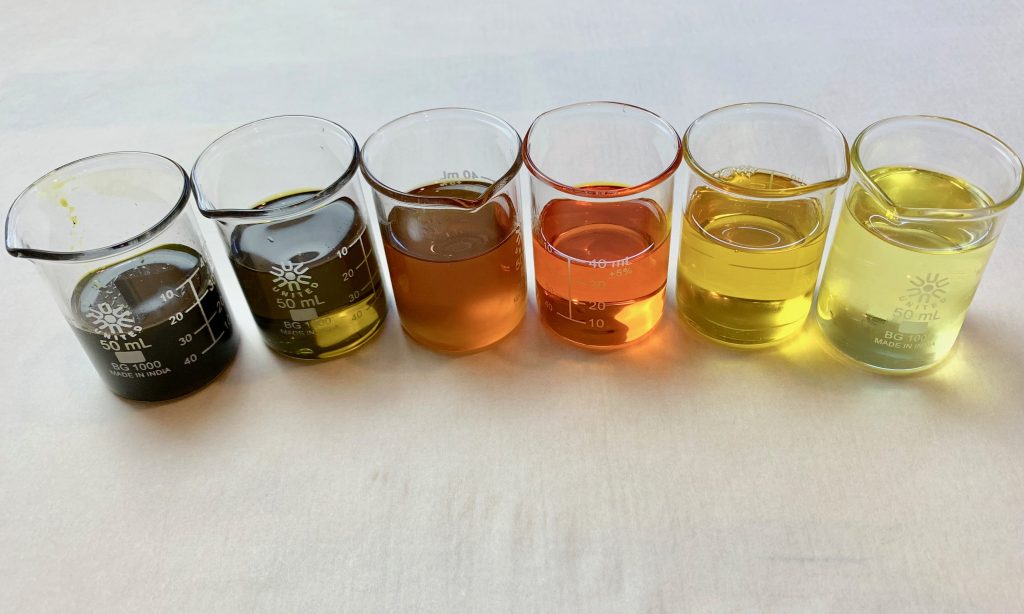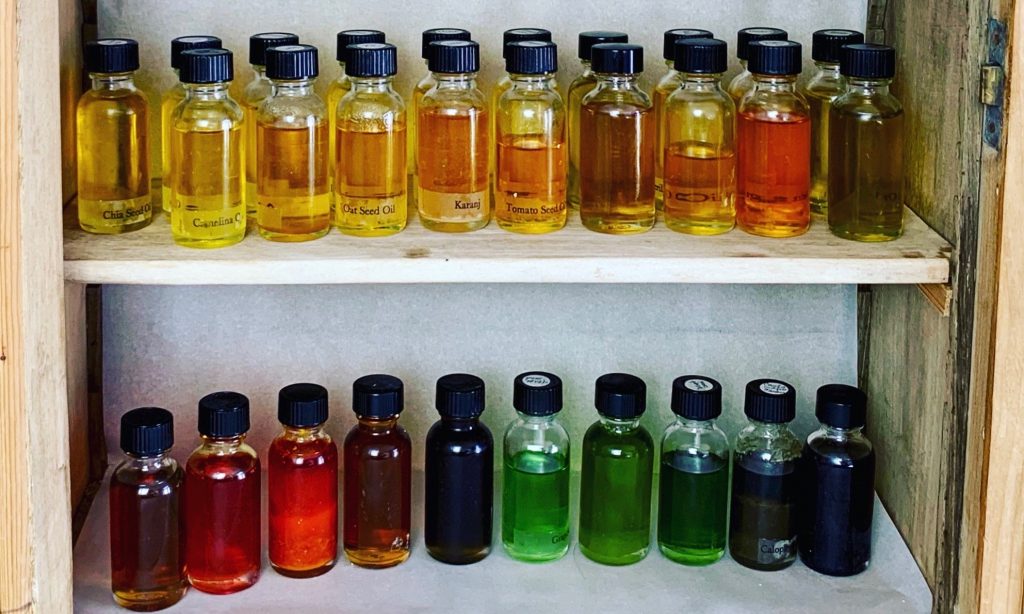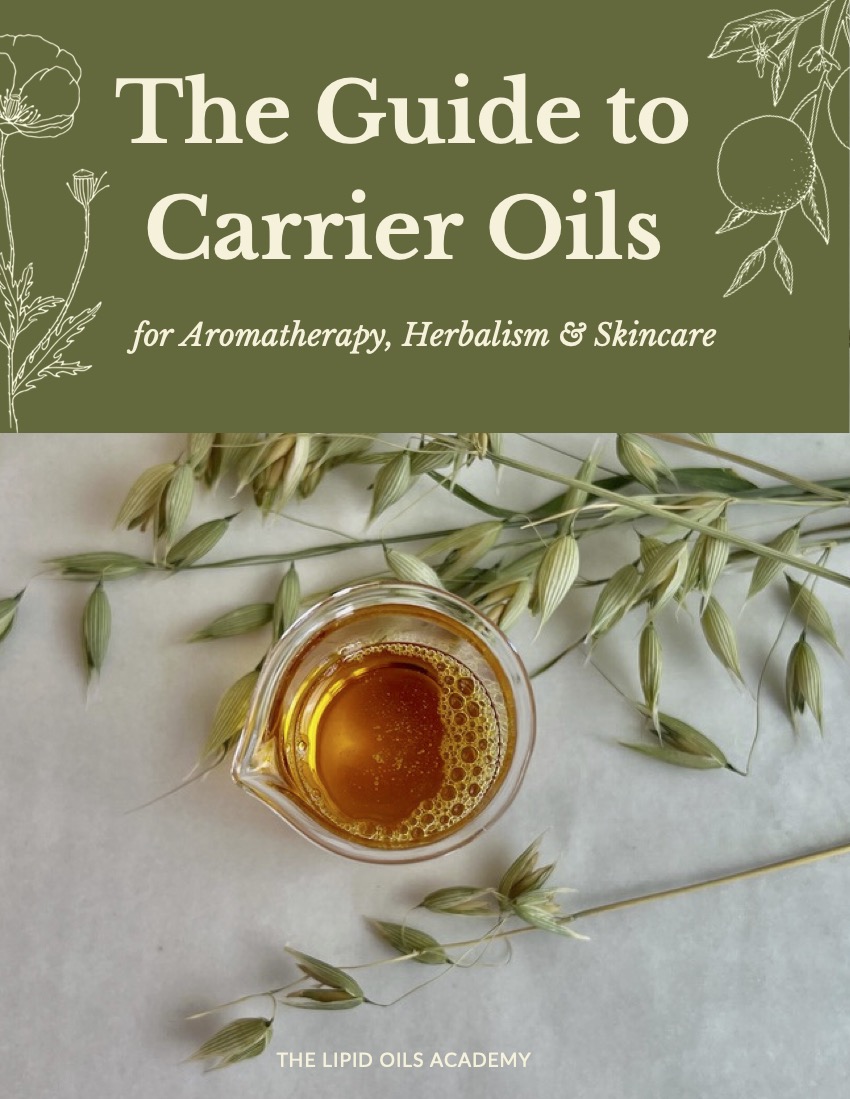Oils come to us in a wide range of colors from pale yellow and clear to bold dark reds, greens, golden yellows, and sometimes almost black or dark purple. And it is these color compounds that hold so much of the beneficial skin-repairing antioxidants we find in oils. These are the unsaponifiables, also known as the healing fraction.
Nature has a complete pallet at her fingertips.
Antioxidants in Oils in the form of Carotenes and Lycopene
We find this pallet in the form of carotenes named for carrots – or perhaps carrots are named for carotenes?
Either way, carotenes are powerful antioxidants that will nourish and protect the body from free radical damage.
Another antioxidant in the carotenoid group is the beautiful reds from lycopene.
What does the term Antioxidant Really Mean?
So what does ‘antioxidant’ mean? Sometimes we can hear words and think we understand them but in a vague kind of way and antioxidant can be one of those terms.
It’s pretty complicated and I’ve tried to wrap my head around it. Here is the process as I understand it.
Oxygen is both life-giving and life killing. Oxidation is a kind of decay, turning apples brown and aging our skin.
But we can’t live without it. Literally.
So an antioxidant is working against oxidation.
Oxidation causes destabilization of atoms or groups of atoms by robbing their outer ring of electrons triggering a free radical cascade.
A free radical is an unstable atom or group of atoms that have missing electrons. So the when we give our bodies anti-oxidants, they give unstable atoms and groups of atoms that make up our cells the electrons they need to return to a stable condition.
That’s the simplified version. Click here for a more scientific paper on this whole process! It’s fascinating and complex.
Nature makes thousands of antioxidant compounds in a wild and colorful mix in fruits, foods, oils, grains, leaves and more.
We need oxygen to live but too much is damaging.
Nature makes these protective compounds to maintain the health and life cycle of plants and other living beings. And we can find these protective antioxidants in oils, especially the ones with intense color.
Back to Carotenoids and Antioxidants in Oils
Carotenoids are not always orange.
And there are over 600 of them!
Yellow, orange, and red colors are common colors for carotenoids but this group also includes xanthophylls which are green.
Lutein and zeaxanthin are two xanthophyll compounds that contribute to the greens and yellows in nature and in our oils.

4,500 Flavonoids
Flavus is the root word of the flavonoid group of antioxidants. Flavus being the word for yellow in Latin. In this group of antioxidants, there are over 4,500 different types but not all forms are yellow.
These flavonoid compounds are also anti-microbial, anti-inflammatory, and anti-allergenic.
Blue and Yellow Makes Green
The green colors in nature and in our oils are also made by mixing the cyanidins which are blue and purple compounds with yellows in Flavus and carotene groups.
Notice this group of words and the single word that shows up in each of them – cyanidin, pro-anthocyanidins and anthocyanidins or anthocyanin.
Cyan is that name for a shade of blue, a kind of sky blue color and we find it in each of these terms for different flavonoids.
So when you find a dark green oil, it’s a good indication of a big dose of flavonoids and carotenes.
So this very brief introduction to the color of oils and shows us that oils are far from just oily! They also have life protecting antioxidants like carotenoids, flavonoids, and other vitamins and minerals, along with the necessary fatty acids that our skin needs to stay supple and healthy.
Unsaponifiables and the Healing Fraction
The term unsaponifiable comes from soap making and is all the compounds in oils that don’t turn into actual soap (saponification). The unsaponifiables are all these antioxidants that we’ve been discussing.
Healing fraction is another term for this portion of the oils and indicates the healing nature of these powerful compounds in the oils.
When you are looking for a carrier oil or a combination of carrier oils, you have this vast palette to work with.

When combining carrier oils or looking for oils for a facial serum or body oil, you want to look at the fatty acid composition and the unsaponifiables or healing fraction. And when you start putting all these factors together, the results are wonderfully healing, nourishing and potent and the combinations nearly limitless.
So what is the best carrier oil to use? with so many colors, fatty acid compositions, shelf life considerations and more there is no one best carrier oil, there are hundreds.
Working with oils is both science and art.
What combinations are you working with right now? Leave a comment below and let me know what you’re working on.



Hi I am working with loquat leaves which I have macerated in sweet almond oil. Have you heard about loquat leaves. In Japan they make tea from the leaves it’s also known as Biwa-cha
Sorry, I am not familiar with the properties of loquat leaves.
I put together a blend of argan, grapeseed infused with calendula flower, castor oil and jojoba oils. The result was very emoillient, especially if my skin is wet. I think the colors are mostly in the flavus range!–but that seems to be a good start—to know how the color contributes to healing.
Tamanu in a personal Essential Oil blend.
Just the other day I mixed up 50% argan, 30% hemp, and 20% tamanu. Soaks in really quickly, and I love the aroma of tamanu.
I love the rich greens in Tamanu and Hemp Seed Oil. The always seem to balance my skin so well.
hi i’m using a base of fractionated coconut oil, rosehip seed oil, evening primrose oil and vitamin e as my carriers to blend my essential oils into. This is making a very nice moisturizing oil that penetrates through the skin and it leaves the scent on me for a long time.
Fabulous info as always Susan! Can you tell me what are those 3 bright green oils in the image (the ones on the bottom shelf) They are stunning and I am so curious! TIA!
Hi Pippin, The green oils are usually grapeseed, tamanu, carrot seed, açaí, hemp, – I’m not sure from where I sit what those were but I’ll check and let you know if it could be others. Some of the labels have come off so there’s that too… They are beautiful.
Hi Susan Thank you for taking a moment to reply! If you figure those out please let me know – I am so curious those bright green oils look delightful! Thanks again –
Hi Susan,
do you have a blog which talk about the difference benefit between Carrot Seed oil and Carrot Tissue oil. Thank you.
Hi Stephanie – carrot tissue oil or root oil would be a maceration infusion. But sometimes it is a CO2 extraction of the root that is added to a base oil. And to answer your question, no I haven’t done carrot seed oil yet. So many oils, so little time!
My scalp and hair is really dry.
I’d love some advice regarding a combination of oil to use for hydration and as a moisturiser
Thank you
I too have dry hair and scalp .. what works well for me is a combination .. put simply mix. One tsp coconut oil one teaspoon sesame oil and half teaspoon castor Oil .. apply to scalp .. then make four part of the hair and apply to hair.
Leave it on for 8 hours and then shampoo ..
I’m using rosehip oil,neem oil, seabuckthorn,eo frankincense
My latest creation is a hair & scalp serum to hydrate, boost hair growth and restore scalp health: for this I have chosen Grapeseed, Camellia, Tamanu and meadowfoam to mix my essential oils in. Tamanu is dark green and very opaque, full of healing fraction, one of my favorite carriers! 🙂
I do not have a good skin. Am elderly. I have started using Black Seed Oil (Nigella Sativa) and currently in a very dry area so am adding a tiny bit of castor oil. Very happy with the results.
Thank you for all the wonderful information that you keeping sending.v Really appreciated. Blessings jenny
.
Am using guava,moringa,evening primose,papaya and kuikui
My face loves this combo
I am working with pomegranate mixed with a little cacay,baru,cactus seed and pracaxi. Since pomegranate is so thick and sticky I cut it with jojoba and apply this to my face and neck. I’ve noticed a nice surprising benefit from this mix- those of you who are progesterone deficient will understand 😊
Hi Linda, I wonder too why pomegranate is so sticky ? Maybe Susan can explain why it is like that. To my skin pomegranate is sticky in the same way castor is, yuk, but if it’s going to help with the ‘benefit’ you mentioned, I might give it whirl too 🙂
Hi Wendy – it is the nature of the fatty acids in pomegranate seed oil that make it thick feeling. It has its own fatty acid named for the plant, punicic acid that twists making the oil feel viscous.
I have been using Kalahari melon seed oil “straight up” these days as a daytime moisturizer after spritzing with hydrosol. Absorption is really quick. The oil is a beautiful golden yellow!